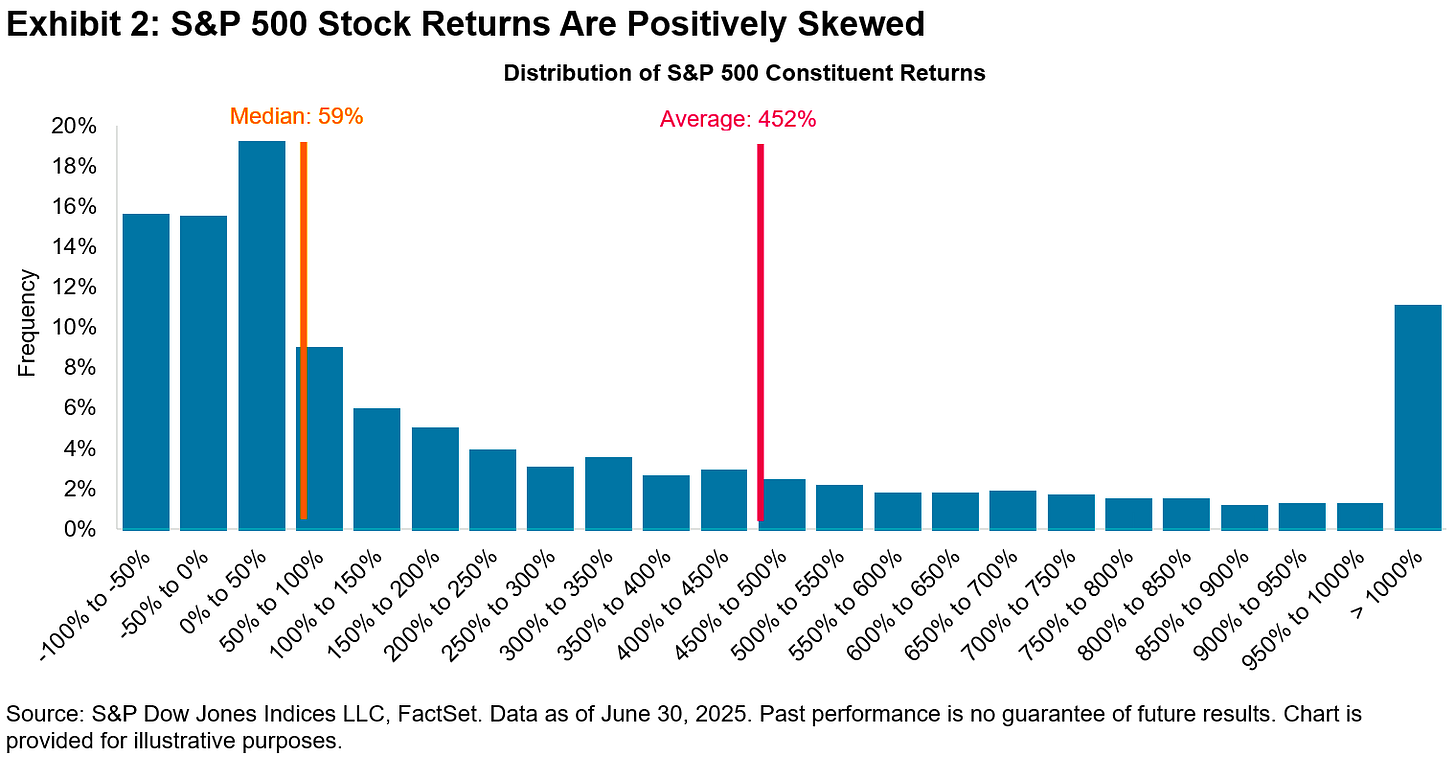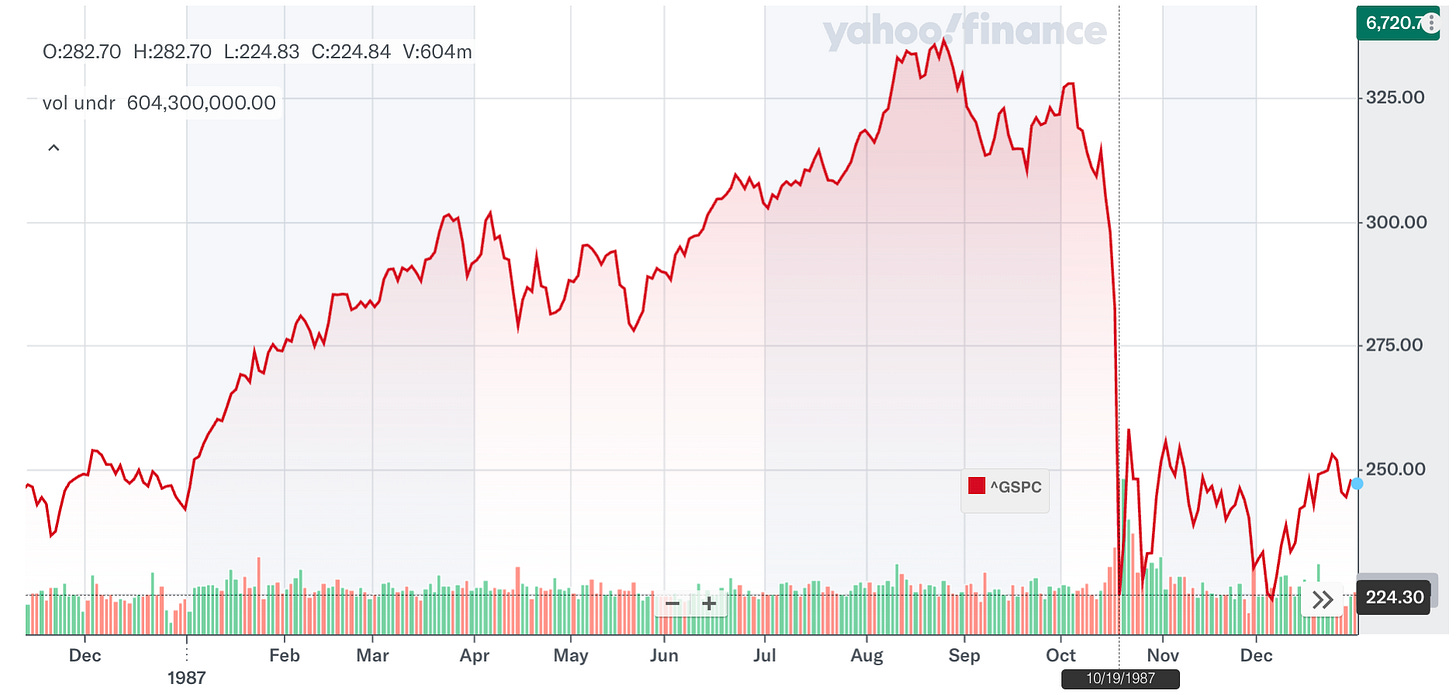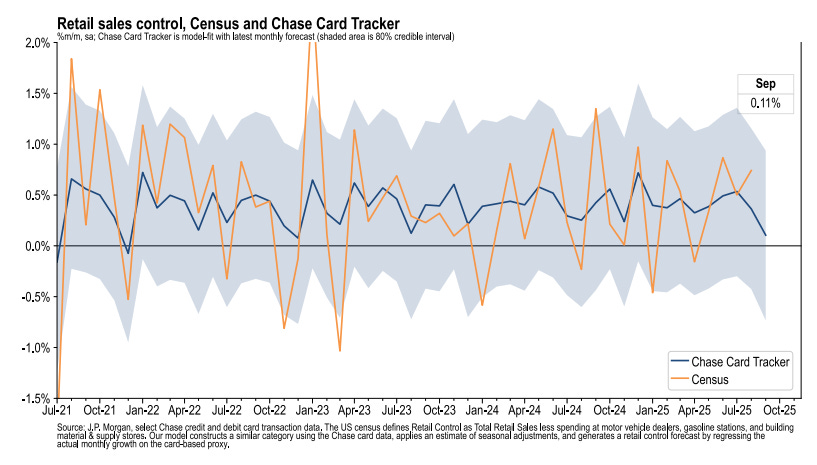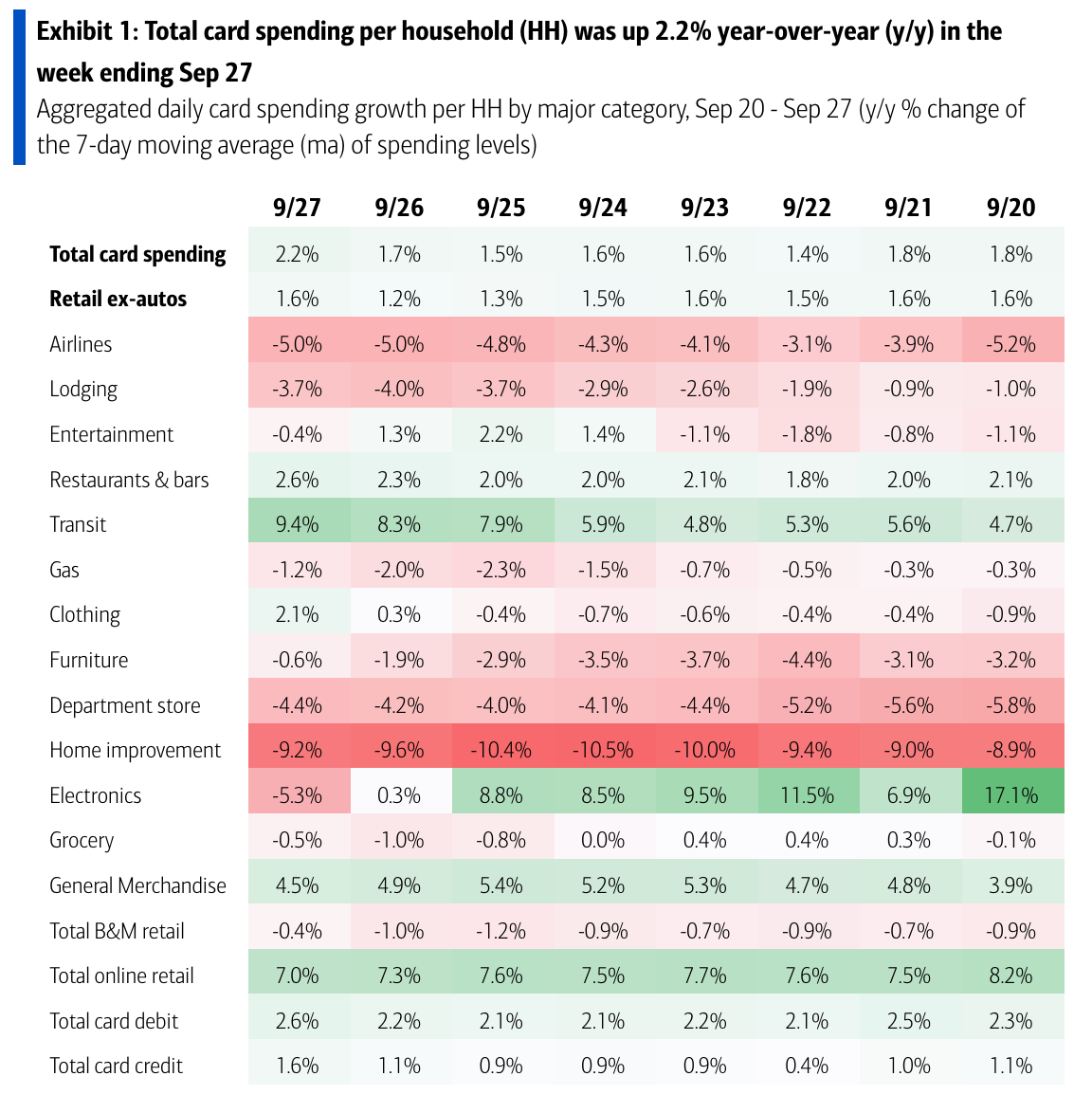2 market-crash facts that surprised me 📉
Plus a charted review of the macro crosscurrents 🔀
📈The stock market rallied to all-time highs, with the S&P 500 setting an intraday high of 6,750.87 and a closing high of 6,715.79 on Friday. The index is now up 14.2% year-to-date. For more on the market, read: The stock market and the economy are diverging 📊
-
When I first got into stock market history about 20 years ago, I recall being regularly surprised by facts and stats that I wouldn’t have assumed.
Two of them related to history’s biggest stock market crashes.
The first was about Black Monday, Oct. 19, 1987. In a single trading session, the Dow fell 508 points, which was a staggering 22.6% at the time. The S&P 500 plummeted 20.4%.
That year, the S&P tumbled 33.5% from its Aug. 25 high to its Dec. 4 low.
The surprising fact: The market was actually positive for the year, with the S&P gaining 2%. The economy didn’t go into recession either.
The second surprise was about the dot-com bubble. From the peak of the internet stock frenzy on March 24, 2000, to its low on Oct. 9, 2002, the S&P 500 fell a breathtaking 49%.
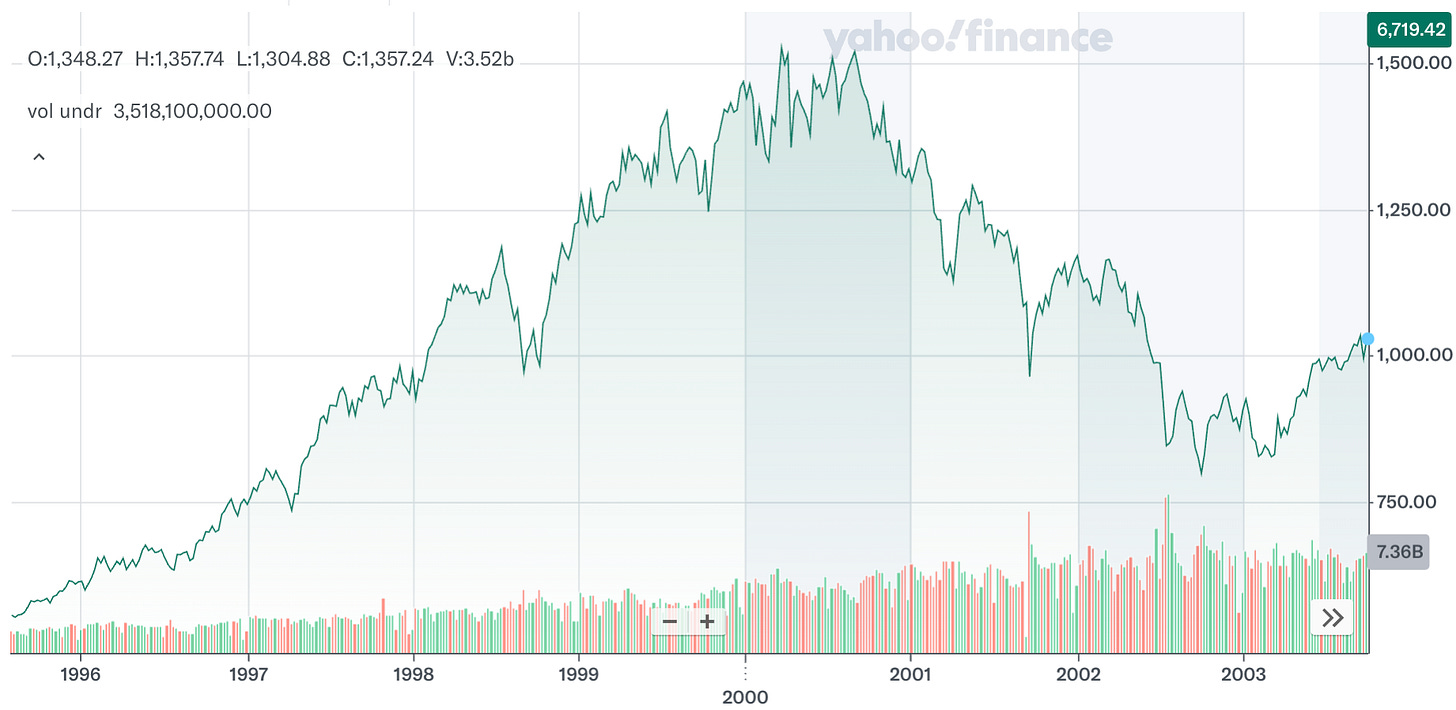
One of the more notable events during the run-up in prices was when then Fed Chair Alan Greenspan famously asked (emphasis added):
But how do we know when irrational exuberance has unduly escalated asset values, which then become subject to unexpected and prolonged contractions as they have in Japan over the past decade?
Looking back, many point to that speech as a prescient warning of the bubble that eventually burst.
The surprising fact: The S&P was at 749 when Greenspan gave that speech on Dec. 5, 1996. After the dot-com bubble burst, the index bottomed in 2002 at 776. The S&P at the post-bubble low was actually higher than where it was when Greenspan gave his speech.*
Timing the market is hard ⏱️
Maybe we are on the precipice of a deep and lengthy market downturn.
Or maybe the rally extends further, so much so that the bottom of the next sell-off ends up being higher than where we are today.
Investing in the stock market can be an unpleasant process. Conservative strategies like buying and holding or dollar-cost averaging into the market are already tough enough.
Trading in and out of the market is an even bigger challenge.
Looking back at past stock market crashes reminds us that timing the market can be a treacherous, money-losing exercise because stocks are anything but predictable in the near-term.
Even when the market appears overpriced, the risk is that you end up selling low and buying back in at a high.
“The hard part about timing the market is you’ve got to be right twice,” Charles Schwab CEO Rick Wurster said on Yahoo Finance. “You’ve got to get out at the right time, and then you’ve got to be able to get back in at the right time, and that’s very hard to do.”
Last year, BofA’s Savita Subramanian reviewed the history and found that the margin of error for profitably trading market tops is very thin. More about that here.
As always, the market tends to reward investors who can put in the time.
“It’s about time in the market, as opposed to timing the market,” Wurster said.
-
*Seven years later, the S&P fell below that 776 low, bottoming at 666 in March 2009. This came after the housing bubble burst, triggering the global financial crisis. Not all bubbles and market crashes are the same.
Related from TKer:
A time-tested way to buy stocks when the market is tumbling 📉
BofA: ‘Q: Is it better to sell early or late? A: Neither.’ ⏰
That time people freaked out about the CAPE ratio 10 years ago 😱
Smart people agree that the best investing wisdom shares a common theme 🧐
Review of the macro crosscurrents 🔀
There were several notable data points and macroeconomic developments since our last review:
🚨Due to the government shutdown, we did not get reports on August construction spending, August factory orders, September job creation and unemployment, and weekly initial jobless claims. Until the government reopens, we’ll be leaning more on private sources of data.
👎 Private jobs decline. According to payroll processor ADP, which tracks private payrolls and employs a different methodology than the BLS, private companies shed 32,000 jobs in September. Declines in small and mid-sized businesses more than offset job gains in large businesses.
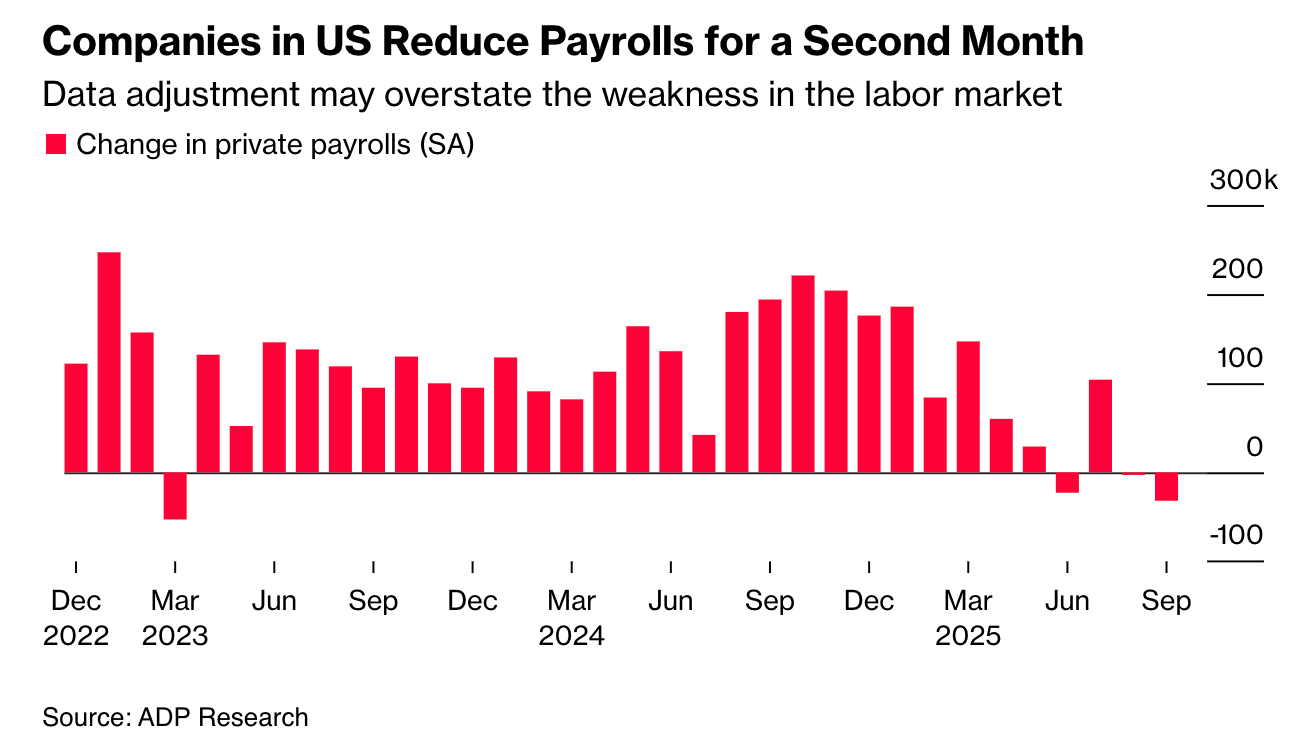
From ADP’s Nela Richardson: “Despite the strong economic growth we saw in the second quarter, this month’s release further validates what we’ve been seeing in the labor market, that U.S. employers have been cautious with hiring.“
For more on the labor market, read: The labor market is cooling 💼
👎 Hiring intentions fall. According to outplacement firm Challenger, Gray & Christmas, companies last month announced plans to add 117,313 jobs, the weakest September since 2011. Year to date, companies announced plans to add 204,939 jobs, the lowest tally since 2009.
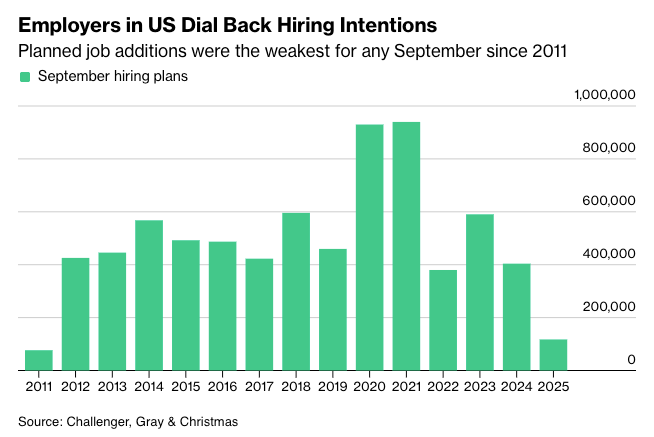
From Challenger’s Andy Challenger: “Right now, we’re dealing with a stagnating labor market, cost increases, and a transformative new technology. With rate cuts on the way, we may see some stabilizing in the job market in the fourth quarter, but other factors could keep employers planning layoffs or holding off hiring.“
For more on why hiring intentions matter, read: The hiring situation 🧩
💰 Job switchers still get better pay. According to ADP, annual pay in September for people who changed jobs was up 7.6% from a year ago. For those who stayed at their job, pay was up 4.5%.
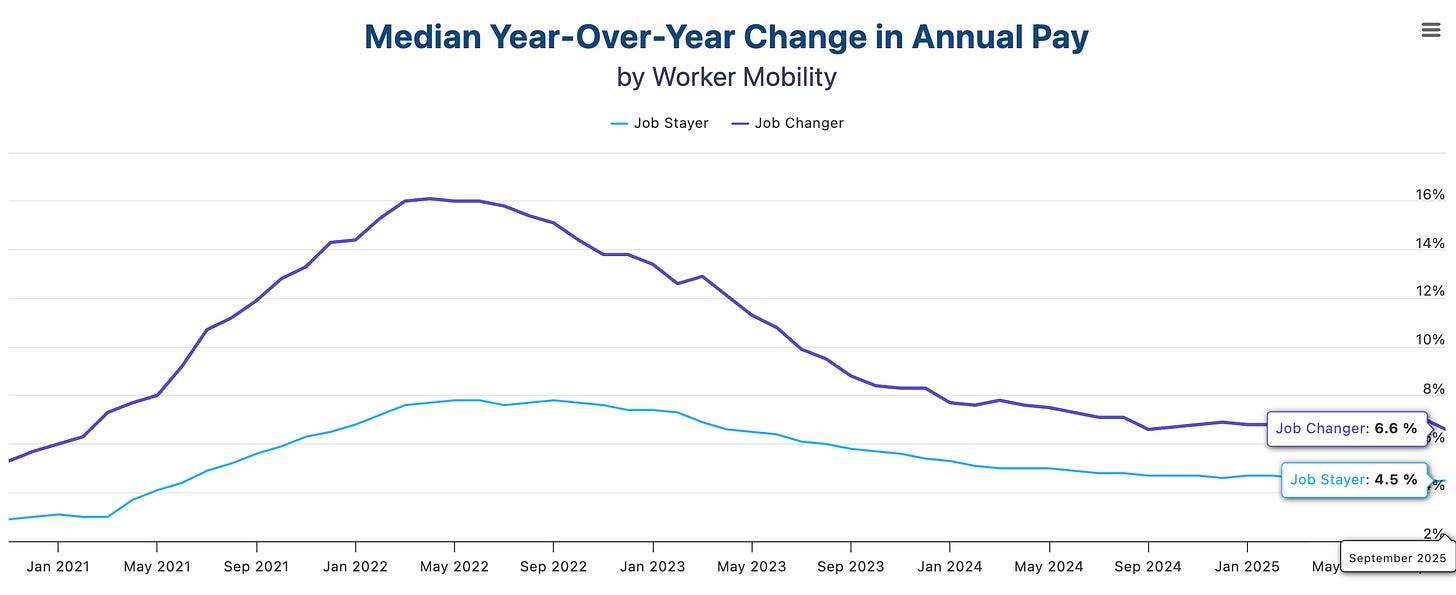
For more on why policymakers are watching wage growth, read: Revisiting the key chart to watch amid the Fed’s war on inflation 📈
💼 Job openings tick higher. According to the BLS’s Job Openings and Labor Turnover Survey, employers had 7.23 million job openings in August, up from 7.21 million in July.
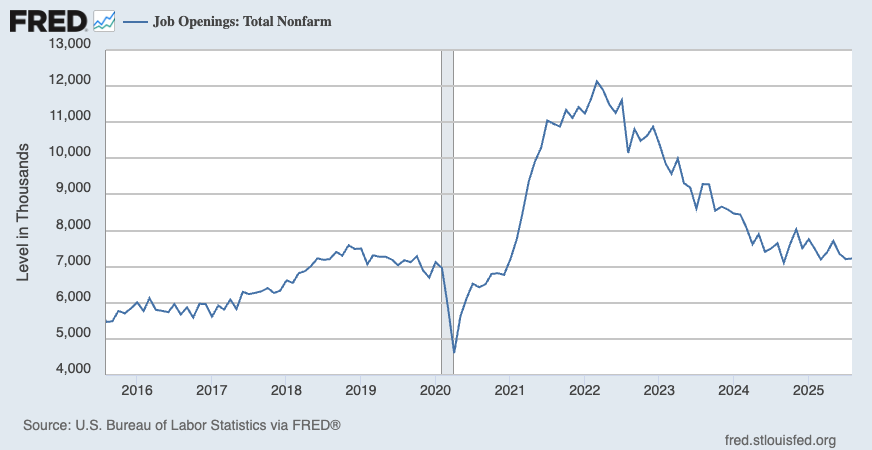
During the month, there were 7.38 million unemployed people — meaning there were 0.98 job openings per unemployed person. This continues to be one of the more obvious signs of excess demand for labor. However, this metric has returned to prepandemic levels.
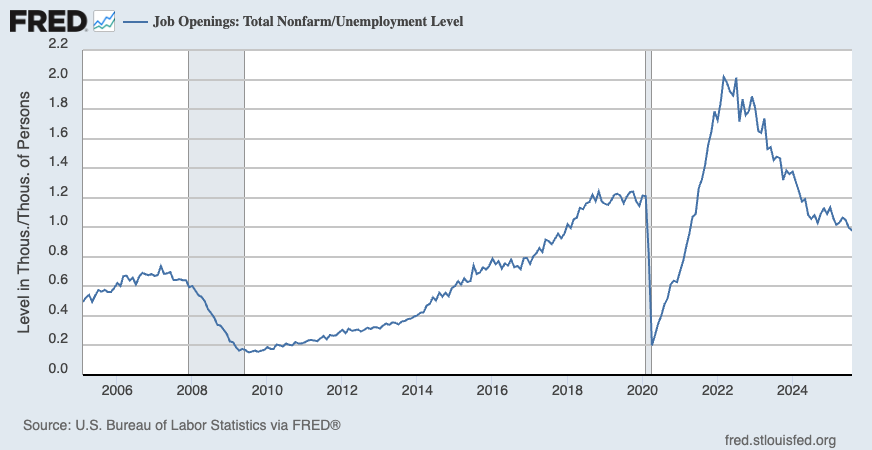
For more on job openings, read: Were there really twice as many job openings as unemployed people? 🤨 and Revisiting the key chart to watch amid the Fed’s war on inflation 📈
👍 Layoffs remain depressed, hiring remains firm. Employers laid off 1.73 million people in August. While challenging for the people affected, this figure represents just 1.1% of total employment. This metric remains slightly below prepandemic levels.
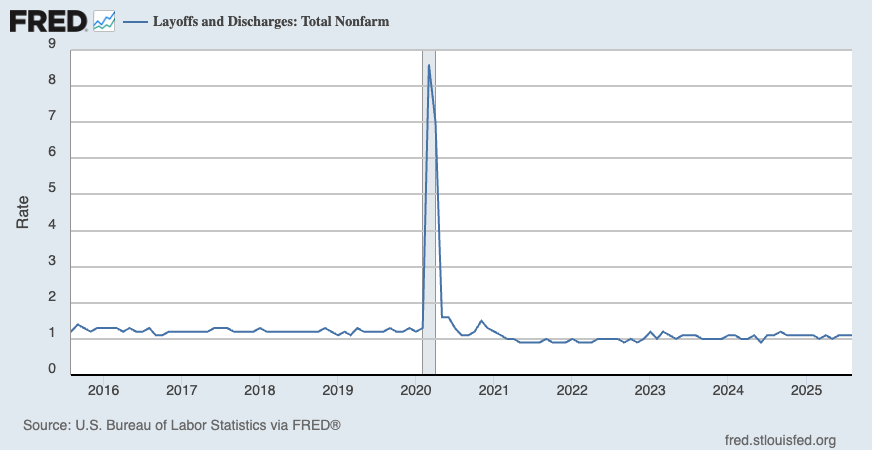
For more on layoffs, read: Every macro layoffs discussion should start with this key metric 📊
Hiring activity continues to be much higher than layoff activity. During the month, employers hired 5.13 million people.
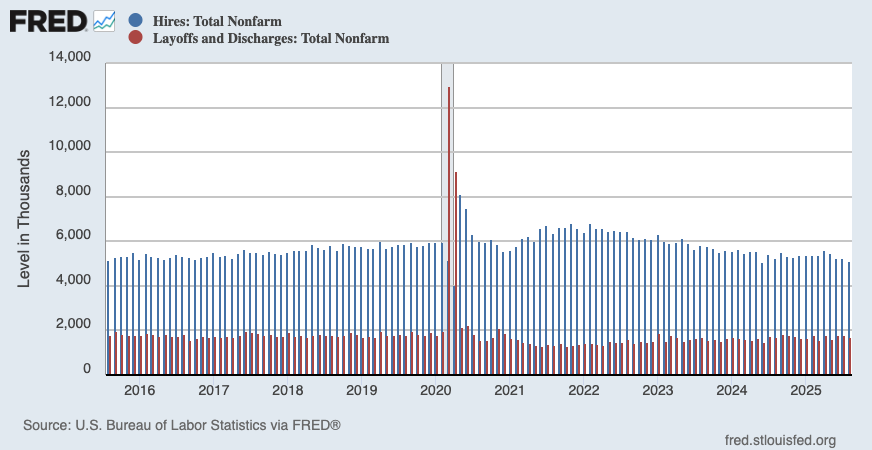
That said, the hiring rate — the number of hires as a percentage of the employed workforce — has been trending lower, which could be a sign of trouble to come in the labor market.
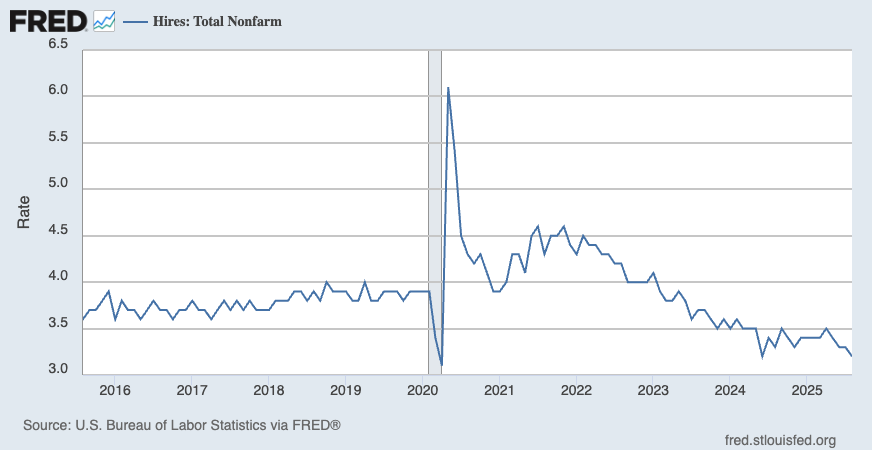
For more on why this metric matters, read: The hiring situation 🧩
🤔 People are quitting less. In August, 3.09 million workers quit their jobs. This represents 1.9% of the workforce. The rate continues to trend below prepandemic levels.
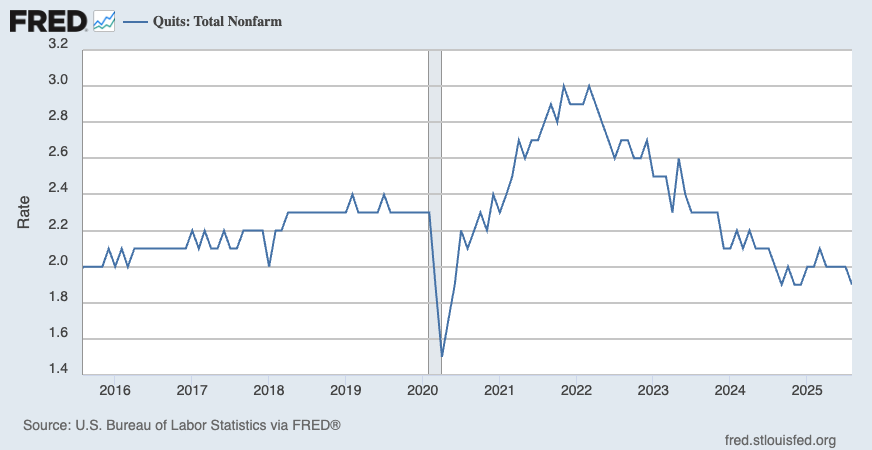
A low quits rate could mean a number of things: more people are satisfied with their job, workers have fewer outside job opportunities, wage growth is cooling, or productivity will improve as fewer people are entering new, unfamiliar roles.
For more, read: Promising signs for productivity ⚙️
👎 Consumer confidence ticks lower. The Conference Board’s Consumer Confidence Index ticked 3.6 points lower in September. From the firm’s Stephanie Guichard: “The present situation component registered its largest drop in a year. Consumers’ assessment of business conditions was much less positive than in recent months, while their appraisal of current job availability fell for the ninth straight month to reach a new multiyear low. This is consistent with the decline in job openings. Expectations also weakened in September, but to a lesser extent. Consumers were a bit more pessimistic about future job availability and future business conditions but optimism about future income increased, mitigating the overall decline in the Expectations Index.”
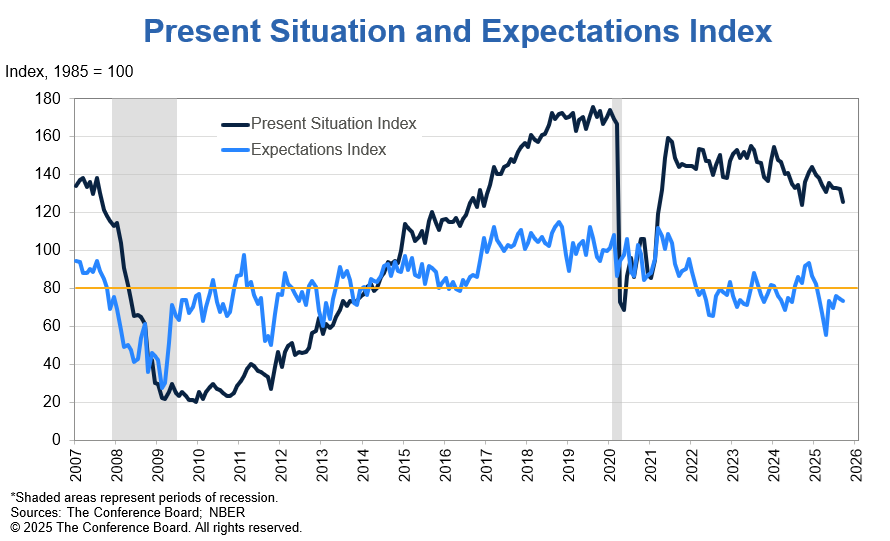
Relatively weak consumer sentiment readings appear to contradict relatively strong consumer spending data. For more on this contradiction, read: What consumers do > what consumers say 🙊 and We’re taking that vacation whether we like it or not 🛫
👎 Consumers feel worse about the labor market. From The Conference Board’s September Consumer Confidence survey: “Consumers’ views of the labor market cooled further in September. 26.9% of consumers said jobs were ‘plentiful,’ down from 30.2% in August. 19.1% of consumers said jobs were ‘hard to get,’ unchanged from last month.“
Many economists monitor the spread between these two percentages (a.k.a., the labor market differential), and it has been reflecting a cooling labor market.
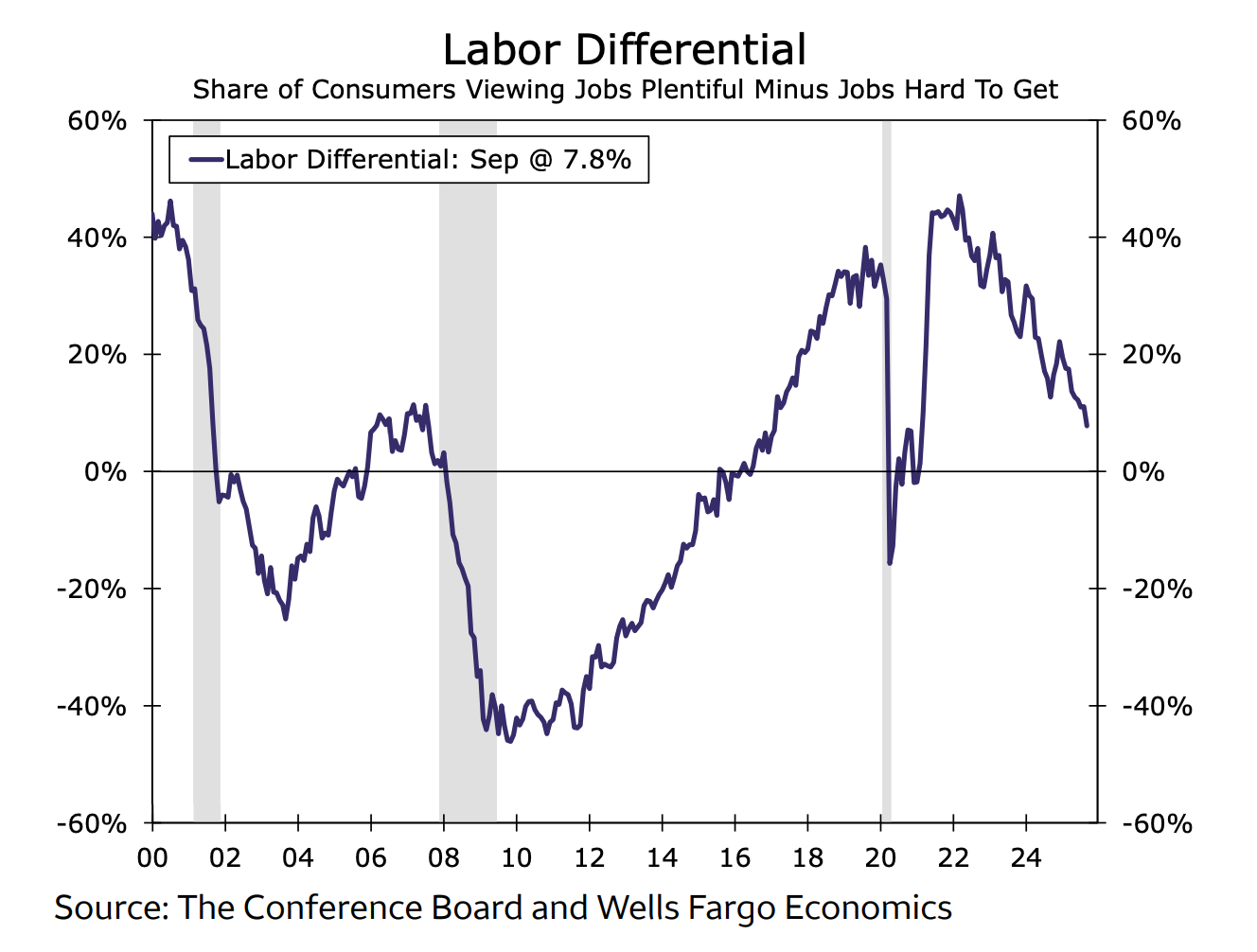
From Wells Fargo: “The trend decline here mirrors the gradual loss of momentum in the labor market over the past couple of years. … The fact that expectations are coming down is part of the recipe for the sort of developments the FOMC will need to see in order to deliver on further rate cuts. Ultimately, the combination of lower rates and a more stimulative fiscal policy environment in 2026 should put the consumer on somewhat less wobbly fundamentals at the start of next year.“
For more on the labor market, read: The labor market is cooling 💼
💳 Card spending data is holding up. From JPMorgan: “As of 25 Sep 2025, our Chase Consumer Card spending data (unadjusted) was 2.4% above the same day last year. Based on the Chase Consumer Card data through 25 Sep 2025, our estimate of the US Census September control measure of retail sales m/m is 0.11%.”
From BofA: “Total card spending per HH was up 2.2% y/y in the week ending Sep 27, according to BAC aggregated credit & debit card data. Y/y electronics spending fell sharply, likely due to base effects from iPhone launch timing (9/20/24 vs. 9/19/25). Spending growth remains solid despite soft labor data.“
For discussion on how sales may be inflated due to tariffs, read: A BIG economic question right now 🤔
⛽️ Gas prices hold steady. From AAA: “The national average for a gallon of regular dropped five cents since last week to $3.15. Fall is officially here, bringing lower gas prices and winter-blend gasoline which is cheaper to produce. Pacific Northwest drivers are getting some relief now that a pipeline issue has been resolved and pump prices are trending downward. The Atlantic hurricane season is halfway over, but the tropics remain a concern for the next two months if there’s storm activity in the Gulf that affects refineries in the area.”
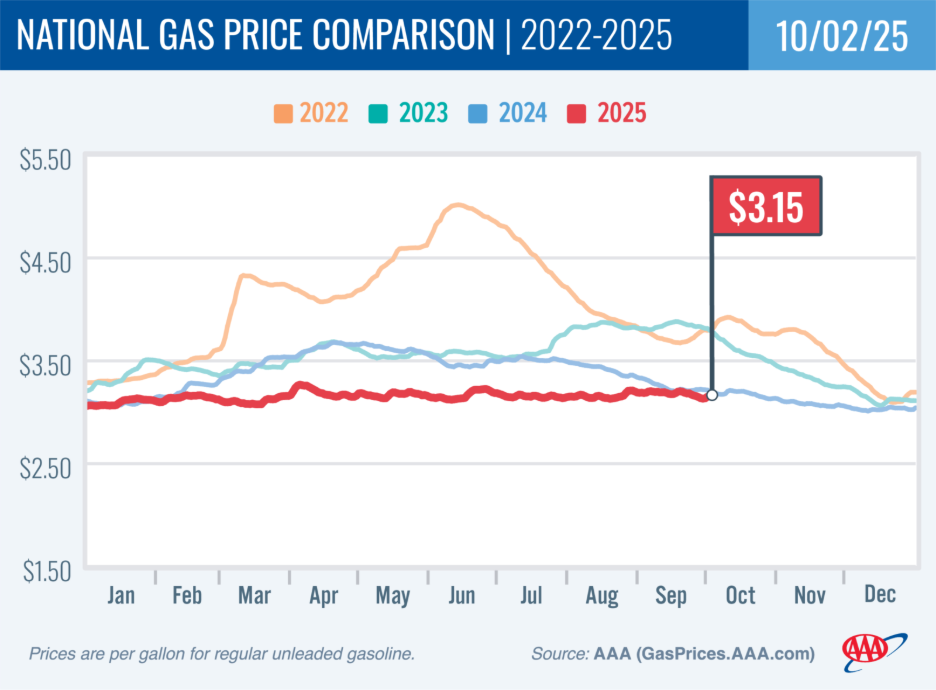
For more on energy prices, read: Higher oil prices meant something different in the past 🛢️
🏠 Mortgage rates tick higher. According to Freddie Mac, the average 30-year fixed-rate mortgage rose to 6.34%, up from 6.30% last week: “The 30-year fixed-rate mortgage increased again this week but remains below its 52-week average of 6.71%. The last few months have brought lower rates and as indicated by the recently reported increase in pending home sales, homebuyers are feeling more confident to get into the market.”
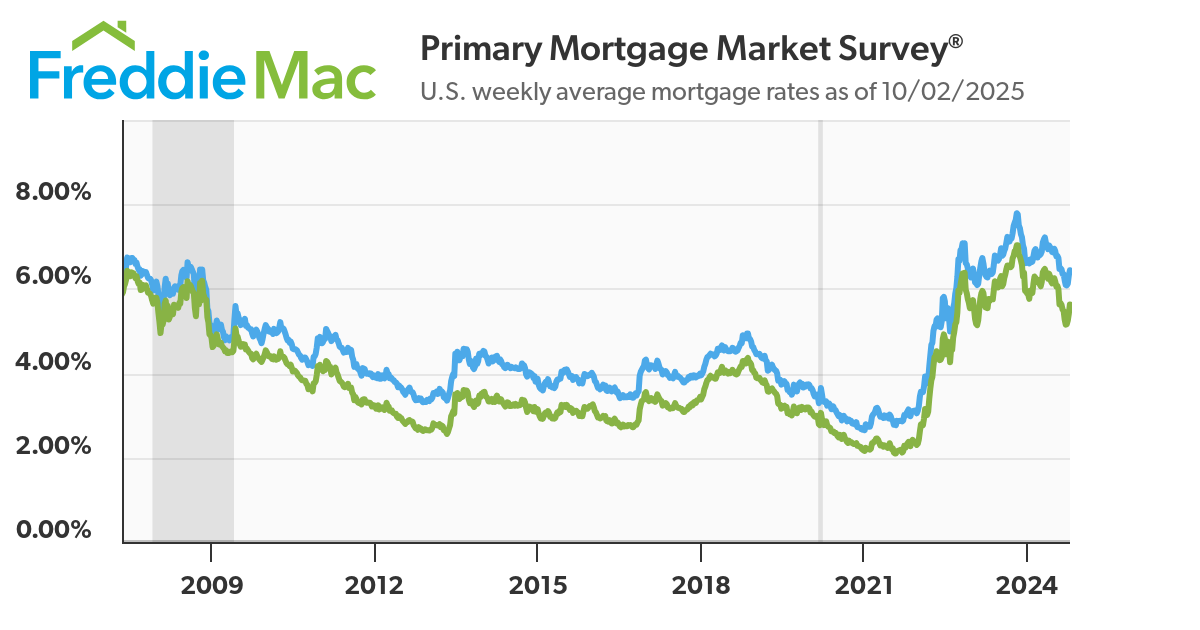
There are 147.9 million housing units in the U.S., of which 86.1 million are owner-occupied and about 39% are mortgage-free. Of those carrying mortgage debt, almost all have fixed-rate mortgages, and most of those mortgages have rates that were locked in before rates surged from 2021 lows. All of this is to say: Most homeowners are not particularly sensitive to the small weekly movements in home prices or mortgage rates.
For more on mortgages and home prices, read: Why home prices and rents are creating all sorts of confusion about inflation 😖
🏠 Home prices cool. According to the S&P CoreLogic Case-Shiller index, home prices were up 1.7% year-over-year in July but declined 0.1% month-over-month. From S&P Dow Jones Indices’ Nicholas Godec: “Looking ahead, the housing market appears to be settling into a new, more measured equilibrium. “The era of 15-20% annual home price jumps is behind us, and in its place we’re seeing growth rates closer to overall inflation – or even a bit below it. While that means homeowners aren’t gaining wealth at the breakneck pace of the recent past, it also signals a potentially healthier trajectory for housing in the long run.”
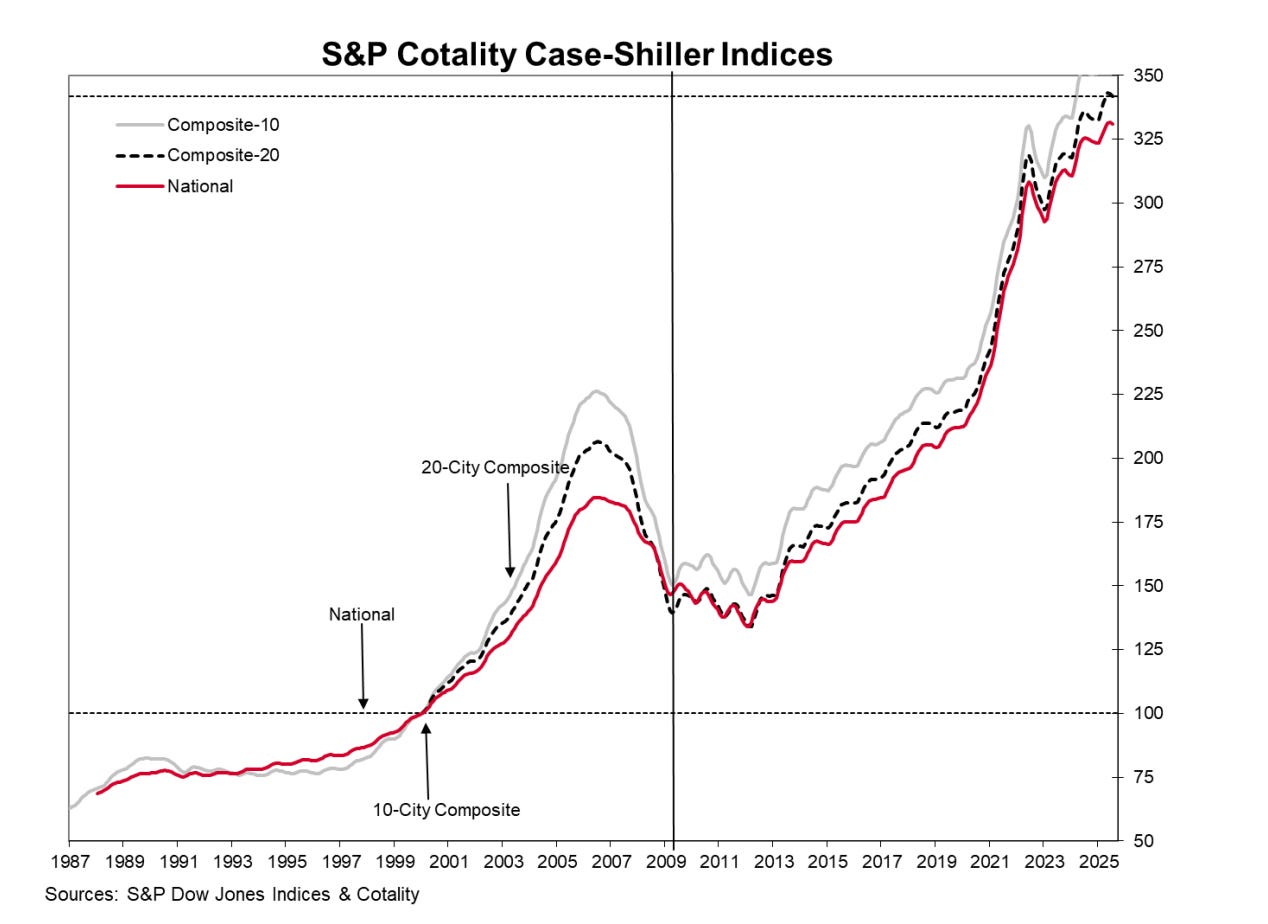
🤷🏻♂️ Manufacturing activity surveys were mixed. From S&P Global’s September U.S. Manufacturing PMI: “US manufacturing production rose for a fourth successive month in September, but the upturn lost momentum as companies reported a drop in order book growth alongside a buildup of unsold finished goods inventories. Despite a slowing in demand growth, many factories produced more goods, using up raw materials that had been stockpiled ahead of tariff implementation. This poses a downside risk to future production in the absence of a pickup in demand, though also hints at some alleviation of price pressures: There is already evidence of companies offering excess stock to customers at reduced rates.”
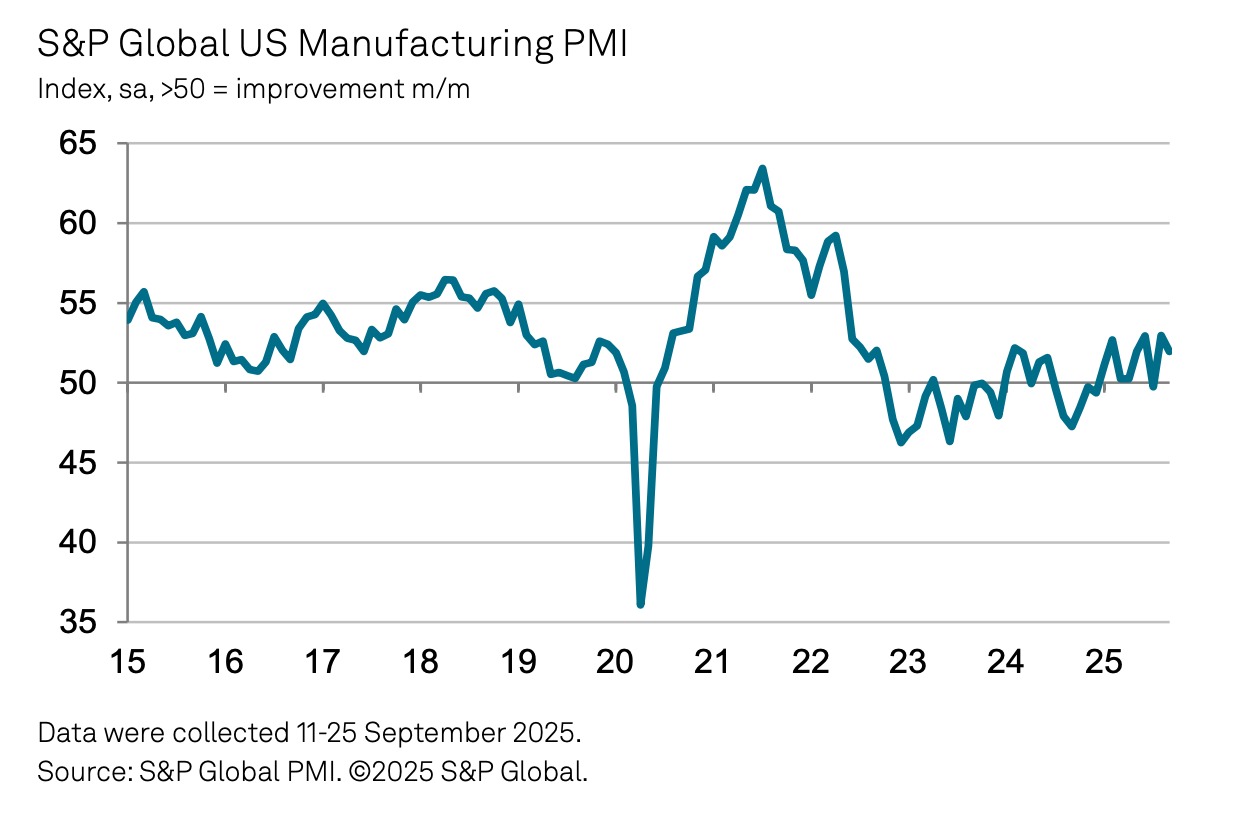
The ISM’s September Manufacturing PMI suggests the sector is in contraction. But the pace of contraction has improved from the prior month.
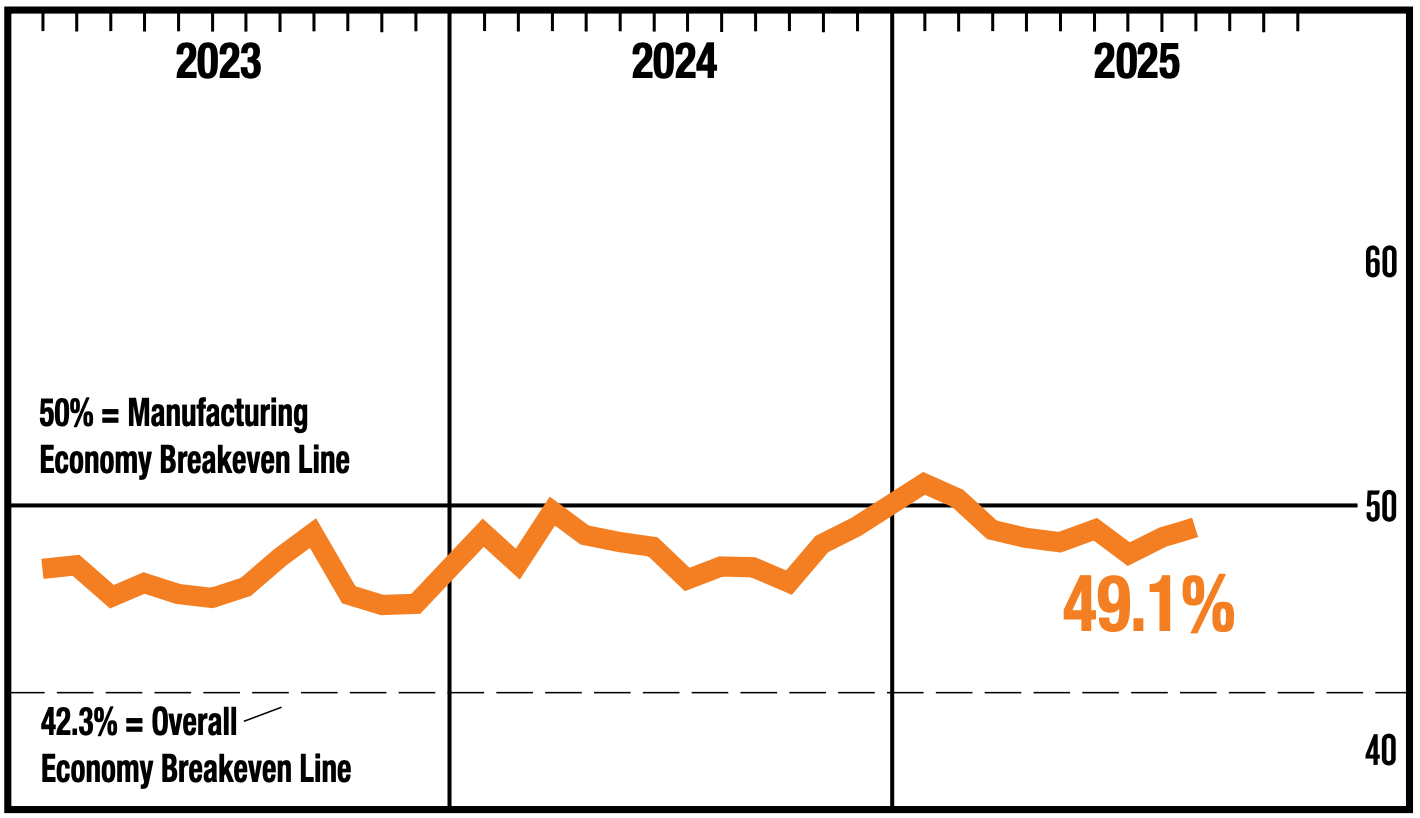
👎 Services activity surveys were mixed. From S&P Global’s September U.S. Services PMI: “Service sector growth softened slightly in September but remained strong enough to round off an impressive performance over the third quarter a whole. Combined with sustained growth in the manufacturing sector, the expansion of service sector activity is indicative of robust third quarter annualized GDP growth of around 2.5%.
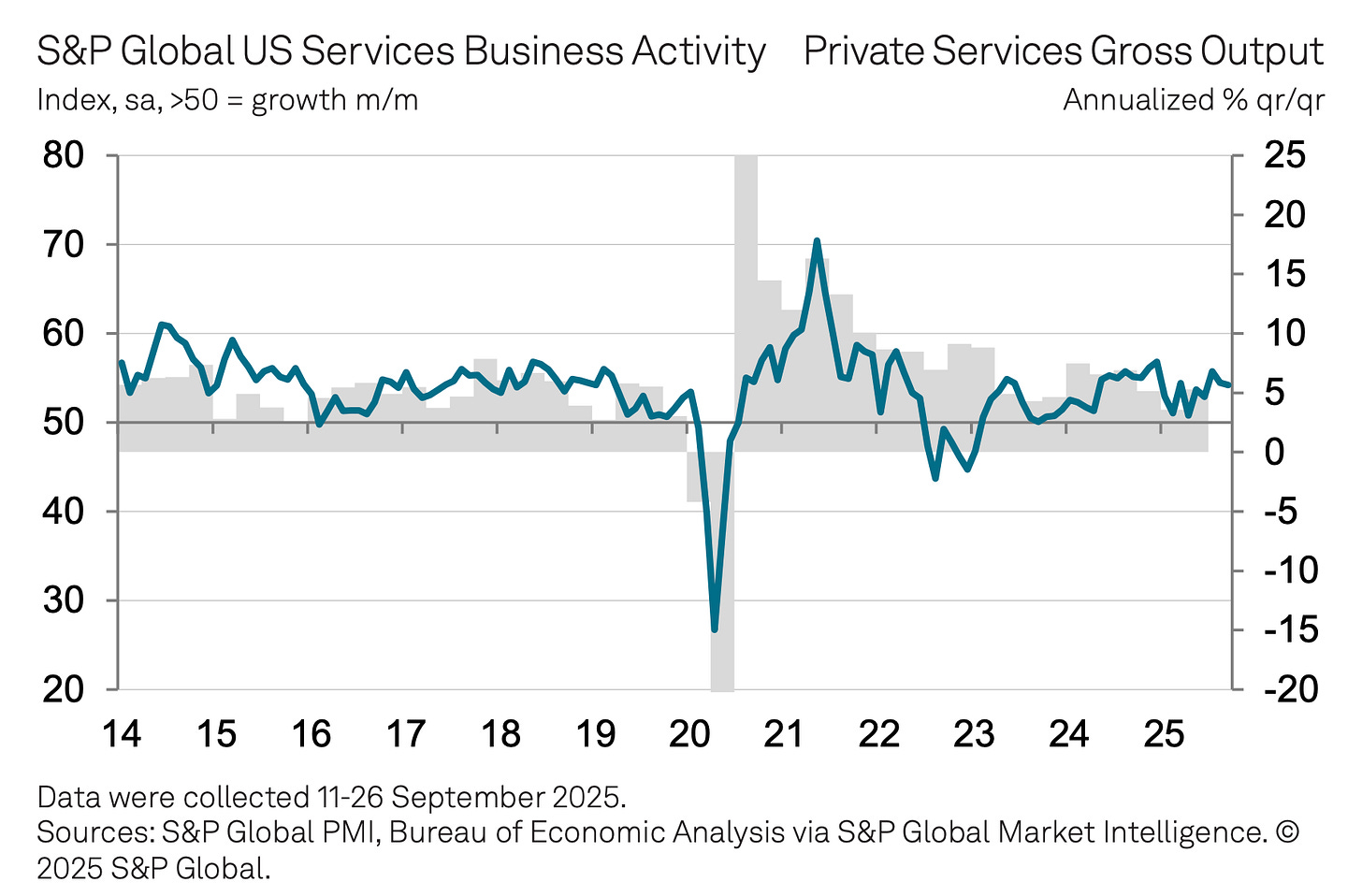
The ISM’s September Services PMI also signaled cooling in the sector.
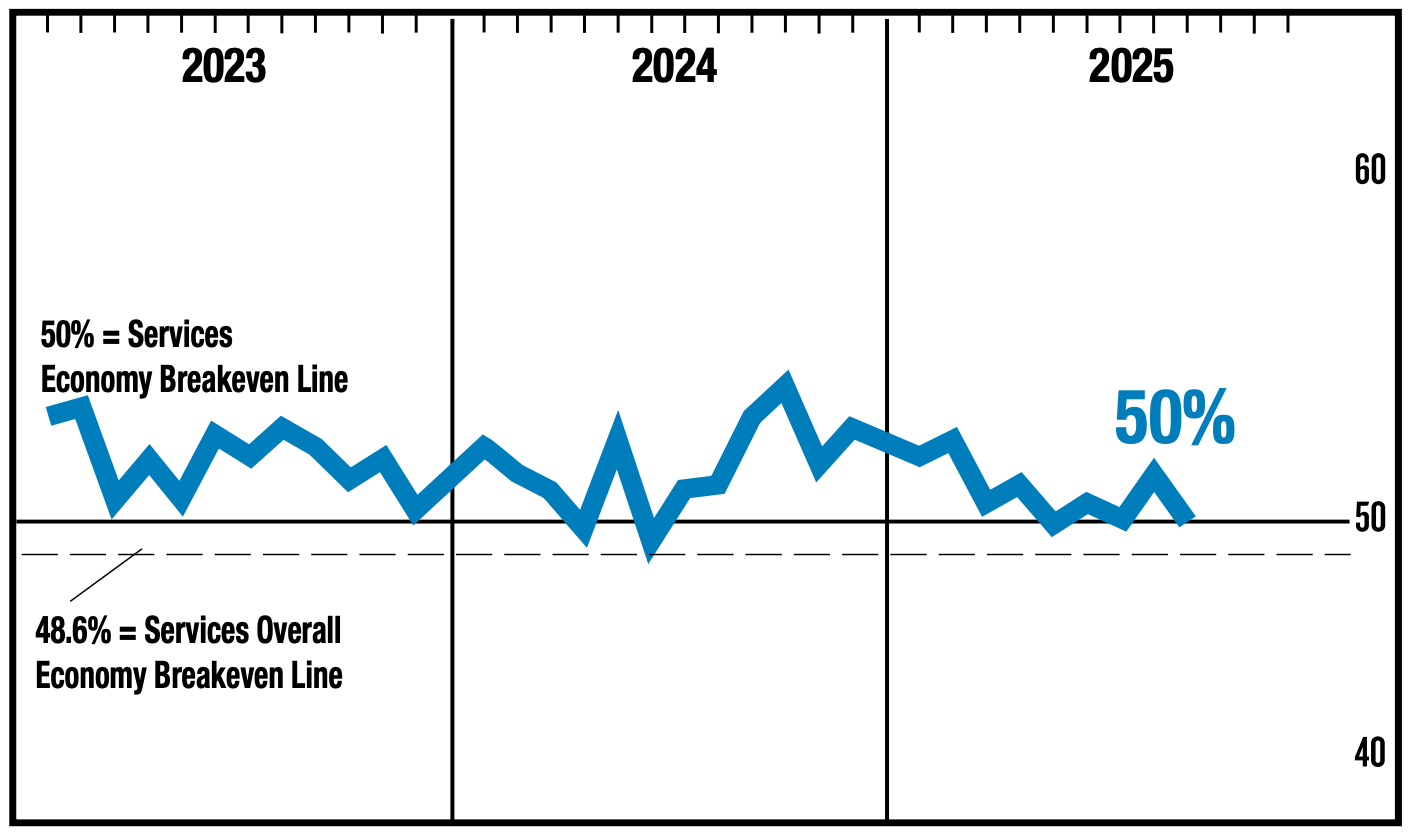
Keep in mind that during times of perceived stress, soft survey data tends to be more exaggerated than actual hard data.
For more on this, read: What businesses do > what businesses say 🙊
🏢 Offices remain relatively empty. From Kastle Systems: “Peak day office occupancy was 62.9% on Wednesday last week, less than one tenth of a point higher than occupancy on Tuesday and two and a half points lower than the previous week, as workers across the country stayed home in observance of Rosh Hashanah. Average occupancy was down every day of the week except Thursday. The average low was on Friday at 33.1%, also down two and a half points from last week.”
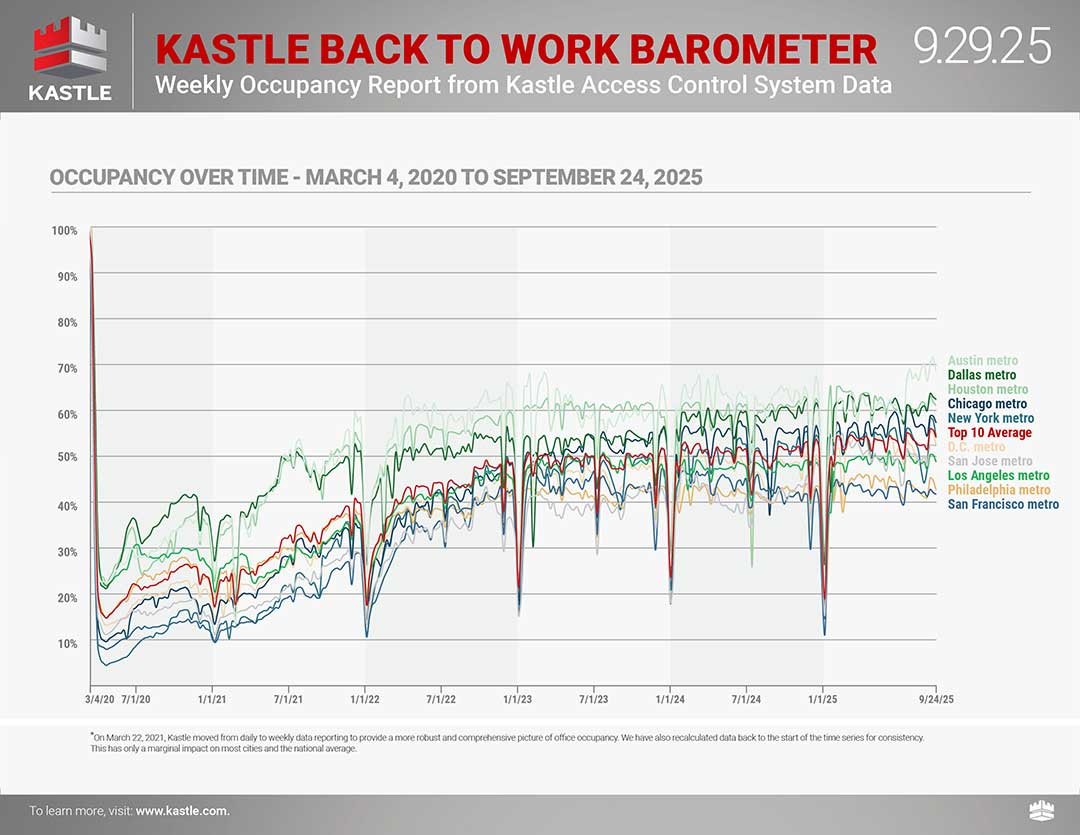
For more on office occupancy, read: This stat about offices reminds us things are far from normal 🏢
📈 Near-term GDP growth estimates are tracking positively. The Atlanta Fed’s GDPNow model sees real GDP growth rising at a 3.8% rate in Q3.
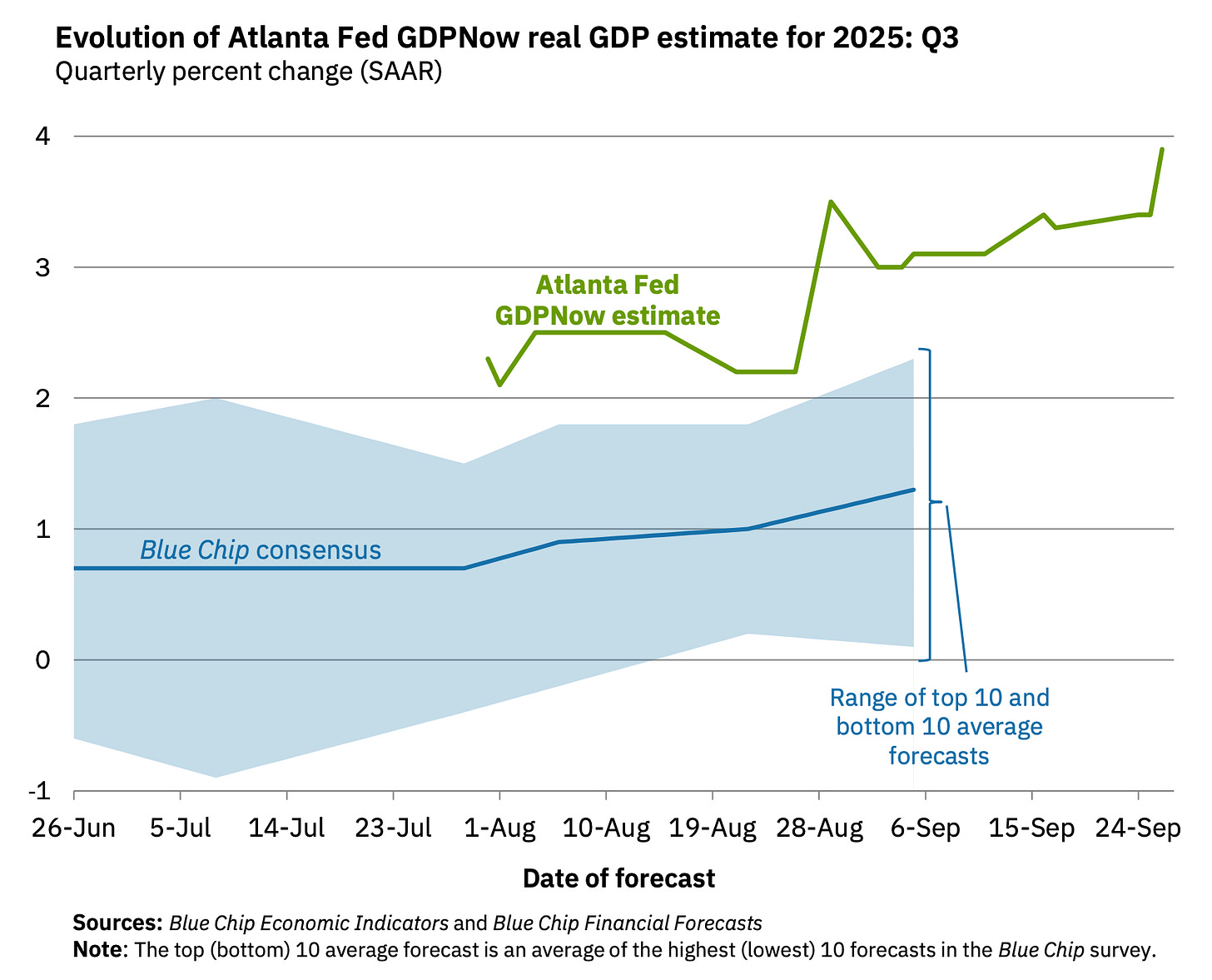
For more on GDP and the economy, read: 9 once-hot economic charts that cooled 📉 and We’re at an economic tipping point ⚖️
Putting it all together 📋
🚨 The Trump administration’s pursuit of tariffs is disrupting global trade, with significant implications for the U.S. economy, corporate earnings, and the stock market. Until we get more clarity, here’s where things stand:
Earnings look bullish: The long-term outlook for the stock market remains favorable, bolstered by expectations for years of earnings growth. And earnings are the most important driver of stock prices.
Demand is positive: Demand for goods and services remains positive, supported by healthy consumer and business balance sheets. Job creation, although cooling, also remains positive, and the Federal Reserve — having resolved the inflation crisis — shifted its focus toward supporting the labor market.
But growth is cooling: While the economy remains healthy, growth has normalized from much hotter levels earlier in the cycle. The economy is less “coiled” these days as major tailwinds like excess job openings and core capex orders have faded. It has become harder to argue that growth is destiny.
Actions speak louder than words: We are in an odd period, given that the hard economic data decoupled from the soft sentiment-oriented data. Consumer and business sentiment has been relatively poor, even as tangible consumer and business activity continues to grow and trend at record levels. From an investor’s perspective, what matters is that the hard economic data continues to hold up.
Stocks are not the economy: There’s a case to be made that the U.S. stock market could outperform the U.S. economy in the near term, thanks largely to positive operating leverage. Since the pandemic, companies have aggressively adjusted their cost structures. This came with strategic layoffs and investment in new equipment, including hardware powered by AI. These moves are resulting in positive operating leverage, which means a modest amount of sales growth — in the cooling economy — is translating to robust earnings growth.
Mind the ever-present risks: Of course, we should not get complacent. There will always be risks to worry about, such as U.S. political uncertainty, geopolitical turmoil, energy price volatility, and cyber attacks. There are also the dreaded unknowns. Any of these risks can flare up and spark short-term volatility in the markets.
Investing is never a smooth ride: There’s also the harsh reality that economic recessions and bear markets are developments that all long-term investors should expect as they build wealth in the markets. Always keep your stock market seat belts fastened.
Think long-term: For now, there’s no reason to believe there’ll be a challenge that the economy and the markets won’t be able to overcome over time. The long game remains undefeated, and it’s a streak that long-term investors can expect to continue.
For more on how the macro story is evolving, check out the previous review of the macro crosscurrents. »
Key insights about the stock market 📈
Here’s a roundup of some of TKer’s most talked-about paid and free newsletters about the stock market. All of the headlines are hyperlinked to the archived pieces.
10 truths about the stock market 📈
The stock market can be an intimidating place: It’s real money on the line, there’s an overwhelming amount of information, and people have lost fortunes in it very quickly. But it’s also a place where thoughtful investors have long accumulated a lot of wealth. The primary difference between those two outlooks is related to misconceptions about the stock market that can lead people to make poor investment decisions.
The makeup of the S&P 500 is constantly changing 🔀
Passive investing is a concept usually associated with buying and holding a fund that tracks an index. And no passive investment strategy has attracted as much attention as buying an S&P 500 index fund. However, the S&P 500 — an index of 500 of the largest U.S. companies — is anything but a static set of 500 stocks.

The key driver of stock prices: Earnings💰
For investors, anything you can ever learn about a company matters only if it also tells you something about earnings. That’s because long-term moves in a stock can ultimately be explained by the underlying company’s earnings, expectations for earnings, and uncertainty about those expectations for earnings. Over time, the relationship between stock prices and earnings has a very tight statistical relationship.
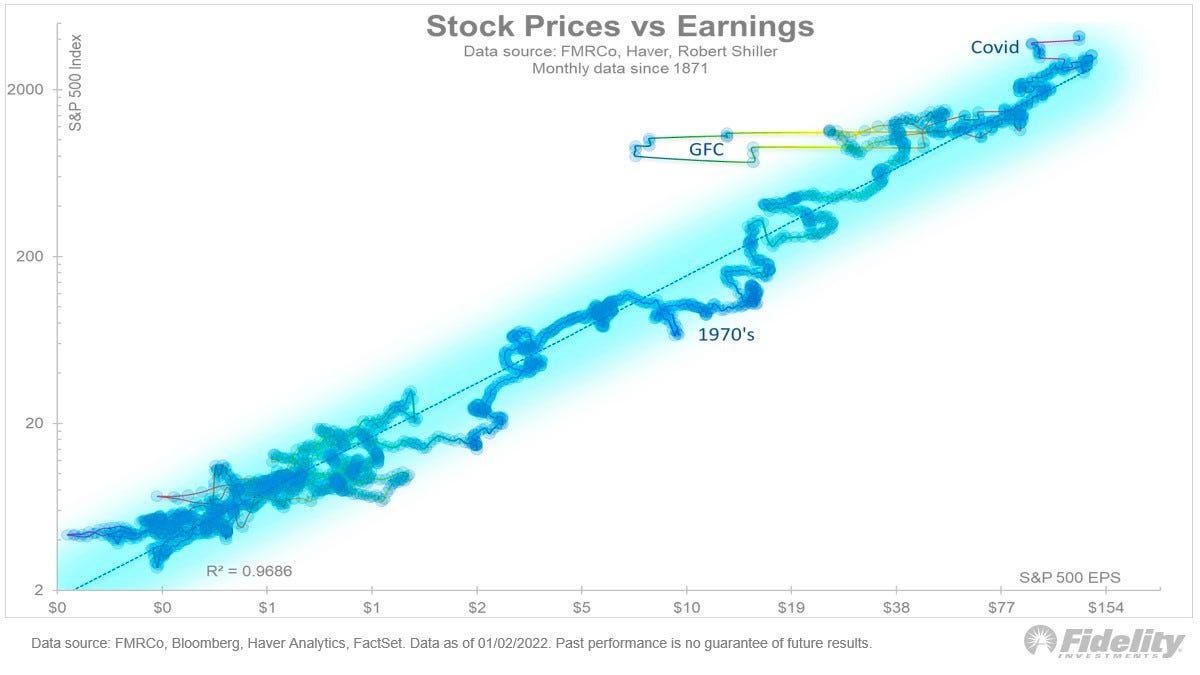
Stomach-churning stock market sell-offs are normal🎢
Investors should always be mentally prepared for some big sell-offs in the stock market. It’s part of the deal when you invest in an asset class that is sensitive to the constant flow of good and bad news. Since 1950, the S&P 500 has seen an average annual max drawdown (i.e., the biggest intra-year sell-off) of 14%.
How the stock market performed around recessions 📉📈
Every recession in history was different. And the range of stock performance around them varied greatly. There are two things worth noting. First, recessions have always been accompanied by a significant drawdown in stock prices. Second, the stock market bottomed and inflected upward long before recessions ended.

In the stock market, time pays ⏳
Since 1928, the S&P 500 generated a positive total return more than 89% of the time over all five-year periods. Those are pretty good odds. When you extend the timeframe to 20 years, you’ll see that there’s never been a period where the S&P 500 didn’t generate a positive return.

What a strong dollar means for stocks 👑
While a strong dollar may be great news for Americans vacationing abroad and U.S. businesses importing goods from overseas, it’s a headwind for multinational U.S.-based corporations doing business in non-U.S. markets.

Economy ≠ Stock Market 🤷♂️
The stock market sorta reflects the economy. But also, not really. The S&P 500 is more about the manufacture and sale of goods. U.S. GDP is more about providing services.
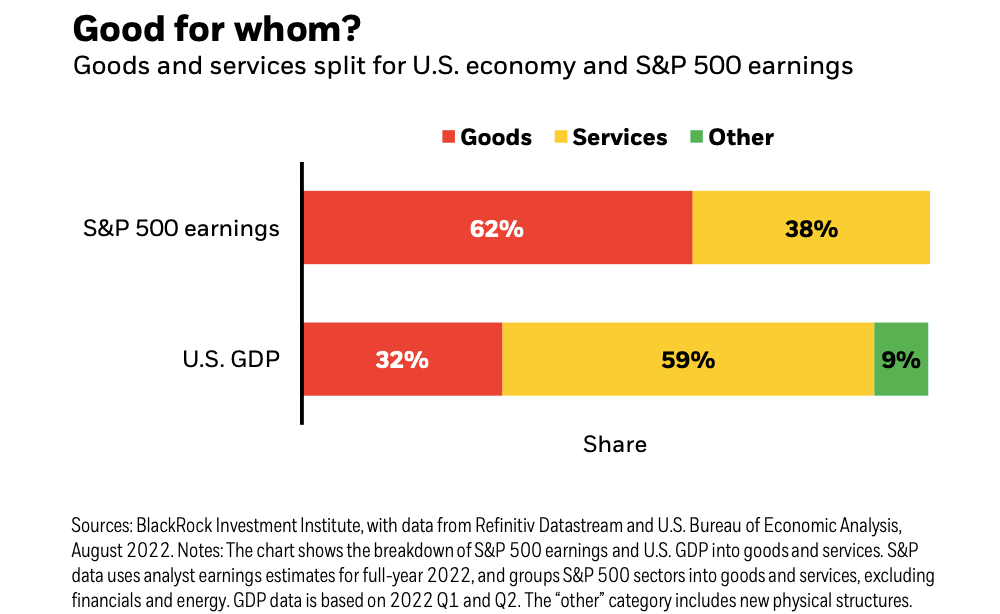
Stanley Druckenmiller's No. 1 piece of advice for novice investors 🧐
…you don't want to buy them when earnings are great, because what are they doing when their earnings are great? They go out and expand capacity. Three or four years later, there's overcapacity and they're losing money. What about when they're losing money? Well, then they’ve stopped building capacity. So three or four years later, capacity will have shrunk and their profit margins will be way up. So, you always have to sort of imagine the world the way it's going to be in 18 to 24 months as opposed to now. If you buy it now, you're buying into every single fad every single moment. Whereas if you envision the future, you're trying to imagine how that might be reflected differently in security prices.
Peter Lynch made a remarkably prescient market observation in 1994 🎯
Some event will come out of left field, and the market will go down, or the market will go up. Volatility will occur. Markets will continue to have these ups and downs. … Basic corporate profits have grown about 8% a year historically. So, corporate profits double about every nine years. The stock market ought to double about every nine years… The next 500 points, the next 600 points — I don’t know which way they’ll go… They’ll double again in eight or nine years after that. Because profits go up 8% a year, and stocks will follow. That's all there is to it.
Warren Buffett's 'fourth law of motion' 📉
Long ago, Sir Isaac Newton gave us three laws of motion, which were the work of genius. But Sir Isaac’s talents didn’t extend to investing: He lost a bundle in the South Sea Bubble, explaining later, “I can calculate the movement of the stars, but not the madness of men.” If he had not been traumatized by this loss, Sir Isaac might well have gone on to discover the Fourth Law of Motion: For investors as a whole, returns decrease as motion increases.
Most pros can’t beat the market 🥊
According to S&P Dow Jones Indices (SPDJI), 65% of U.S. large-cap equity fund managers underperformed the S&P 500 in 2024. As you stretch the time horizon, the numbers get even more dismal. Over a three-year period, 85% underperformed. Over a 10-year period, 90% underperformed. And over a 20-year period, 92% underperformed. This 2023 performance follows 14 consecutive years in which the majority of fund managers in this category have lagged the index.
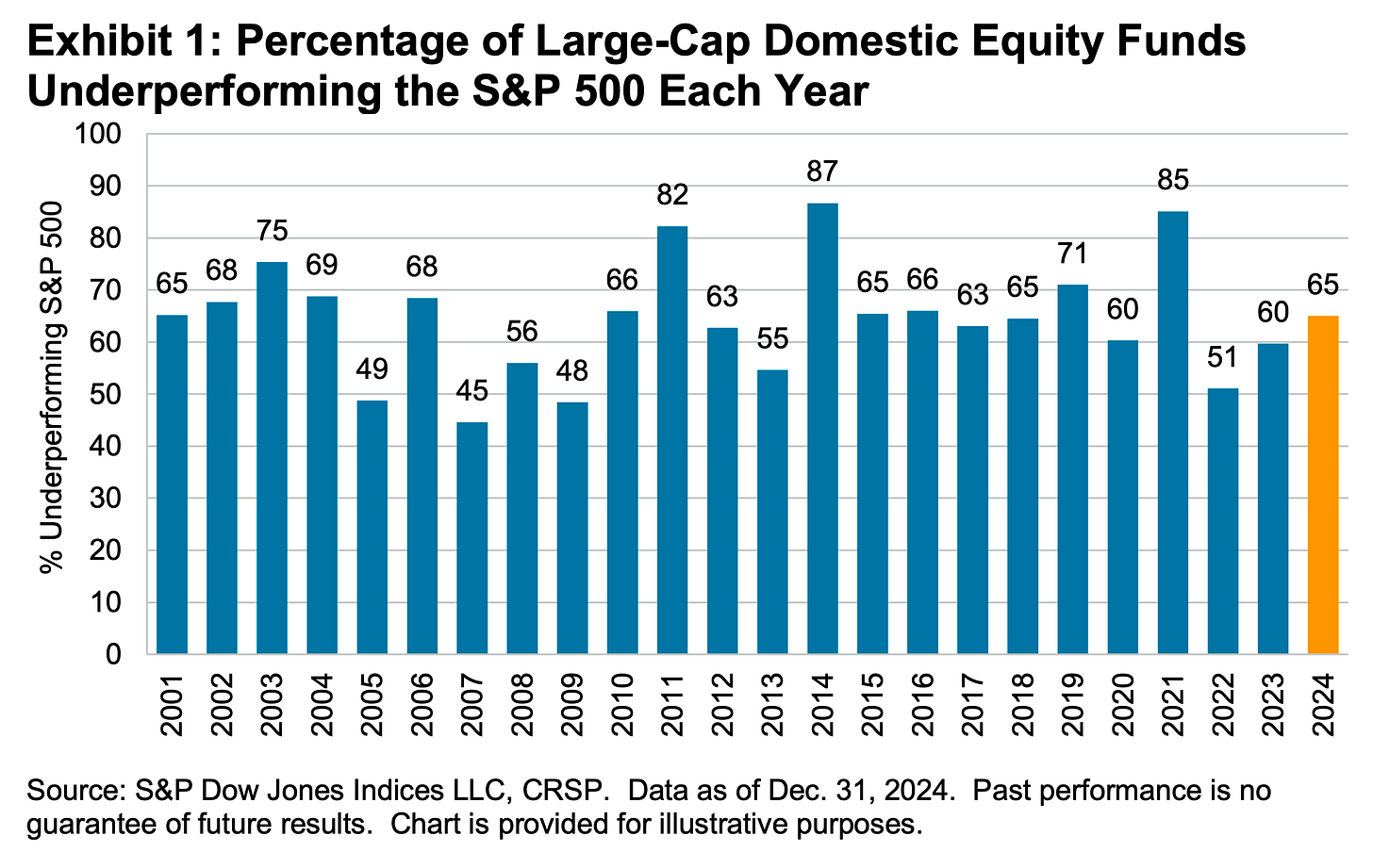
Proof that 'past performance is no guarantee of future results' 📊
Even if you are a fund manager who generated industry-leading returns in one year, history says it’s an almost insurmountable task to stay on top consistently in subsequent years. According to S&P Dow Jones Indices, just 4.21% of all U.S. equity funds in the top half of performance during the first year were able to remain in the top during the four subsequent years. Only 2.42% of U.S. large-cap funds remained in the top half
SPDJI’s report also considered fund performance relative to their benchmarks over the past three years. Of 738 U.S. large-cap equity funds tracked by SPDJI, 50.68% beat the S&P 500 in 2022. Just 5.08% beat the S&P in the two years ending 2023. And only 2.14% of the funds beat the index over the three years ending in 2024.

The odds are stacked against stock pickers 🎲
Picking stocks in an attempt to beat market averages is an incredibly challenging and sometimes money-losing effort. Most professional stock pickers aren’t able to do this consistently. One of the reasons for this is that most stocks don’t deliver above-average returns. According to S&P Dow Jones Indices, only 19% of the stocks in the S&P 500 outperformed the average stock’s return from 2001 to 2025. Over this period, the average return on an S&P 500 stock was 452%, while the median stock rose by just 59%.
